Djamé Seddah
ModernBERT or DeBERTaV3? Examining Architecture and Data Influence on Transformer Encoder Models Performance
Apr 11, 2025Abstract:Pretrained transformer-encoder models like DeBERTaV3 and ModernBERT introduce architectural advancements aimed at improving efficiency and performance. Although the authors of ModernBERT report improved performance over DeBERTaV3 on several benchmarks, the lack of disclosed training data and the absence of comparisons using a shared dataset make it difficult to determine whether these gains are due to architectural improvements or differences in training data. In this work, we conduct a controlled study by pretraining ModernBERT on the same dataset as CamemBERTaV2, a DeBERTaV3 French model, isolating the effect of model design. Our results show that the previous model generation remains superior in sample efficiency and overall benchmark performance, with ModernBERT's primary advantage being faster training and inference speed. However, the new proposed model still provides meaningful architectural improvements compared to earlier models such as BERT and RoBERTa. Additionally, we observe that high-quality pre-training data accelerates convergence but does not significantly improve final performance, suggesting potential benchmark saturation. These findings show the importance of disentangling pretraining data from architectural innovations when evaluating transformer models.
Beyond Dataset Creation: Critical View of Annotation Variation and Bias Probing of a Dataset for Online Radical Content Detection
Dec 16, 2024Abstract:The proliferation of radical content on online platforms poses significant risks, including inciting violence and spreading extremist ideologies. Despite ongoing research, existing datasets and models often fail to address the complexities of multilingual and diverse data. To bridge this gap, we introduce a publicly available multilingual dataset annotated with radicalization levels, calls for action, and named entities in English, French, and Arabic. This dataset is pseudonymized to protect individual privacy while preserving contextual information. Beyond presenting our \href{https://gitlab.inria.fr/ariabi/counter-dataset-public}{freely available dataset}, we analyze the annotation process, highlighting biases and disagreements among annotators and their implications for model performance. Additionally, we use synthetic data to investigate the influence of socio-demographic traits on annotation patterns and model predictions. Our work offers a comprehensive examination of the challenges and opportunities in building robust datasets for radical content detection, emphasizing the importance of fairness and transparency in model development.
Common Ground, Diverse Roots: The Difficulty of Classifying Common Examples in Spanish Varieties
Dec 16, 2024Abstract:Variations in languages across geographic regions or cultures are crucial to address to avoid biases in NLP systems designed for culturally sensitive tasks, such as hate speech detection or dialog with conversational agents. In languages such as Spanish, where varieties can significantly overlap, many examples can be valid across them, which we refer to as common examples. Ignoring these examples may cause misclassifications, reducing model accuracy and fairness. Therefore, accounting for these common examples is essential to improve the robustness and representativeness of NLP systems trained on such data. In this work, we address this problem in the context of Spanish varieties. We use training dynamics to automatically detect common examples or errors in existing Spanish datasets. We demonstrate the efficacy of using predicted label confidence for our Datamaps \cite{swayamdipta-etal-2020-dataset} implementation for the identification of hard-to-classify examples, especially common examples, enhancing model performance in variety identification tasks. Additionally, we introduce a Cuban Spanish Variety Identification dataset with common examples annotations developed to facilitate more accurate detection of Cuban and Caribbean Spanish varieties. To our knowledge, this is the first dataset focused on identifying the Cuban, or any other Caribbean, Spanish variety.
CamemBERT 2.0: A Smarter French Language Model Aged to Perfection
Nov 13, 2024Abstract:French language models, such as CamemBERT, have been widely adopted across industries for natural language processing (NLP) tasks, with models like CamemBERT seeing over 4 million downloads per month. However, these models face challenges due to temporal concept drift, where outdated training data leads to a decline in performance, especially when encountering new topics and terminology. This issue emphasizes the need for updated models that reflect current linguistic trends. In this paper, we introduce two new versions of the CamemBERT base model-CamemBERTav2 and CamemBERTv2-designed to address these challenges. CamemBERTav2 is based on the DeBERTaV3 architecture and makes use of the Replaced Token Detection (RTD) objective for better contextual understanding, while CamemBERTv2 is built on RoBERTa, which uses the Masked Language Modeling (MLM) objective. Both models are trained on a significantly larger and more recent dataset with longer context length and an updated tokenizer that enhances tokenization performance for French. We evaluate the performance of these models on both general-domain NLP tasks and domain-specific applications, such as medical field tasks, demonstrating their versatility and effectiveness across a range of use cases. Our results show that these updated models vastly outperform their predecessors, making them valuable tools for modern NLP systems. All our new models, as well as intermediate checkpoints, are made openly available on Huggingface.
Cloaked Classifiers: Pseudonymization Strategies on Sensitive Classification Tasks
Jun 25, 2024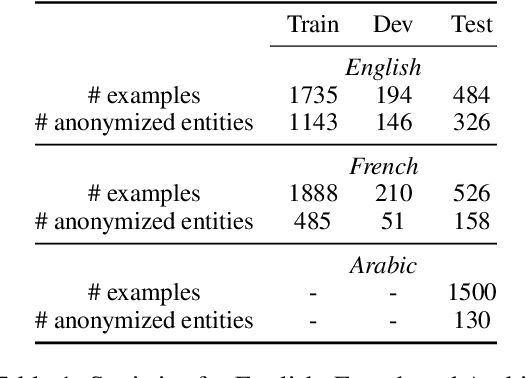
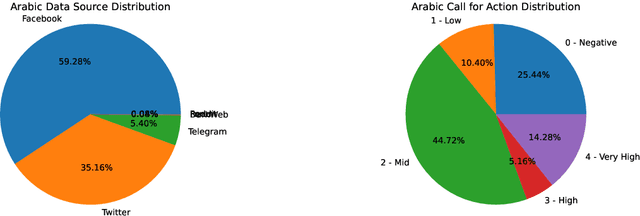

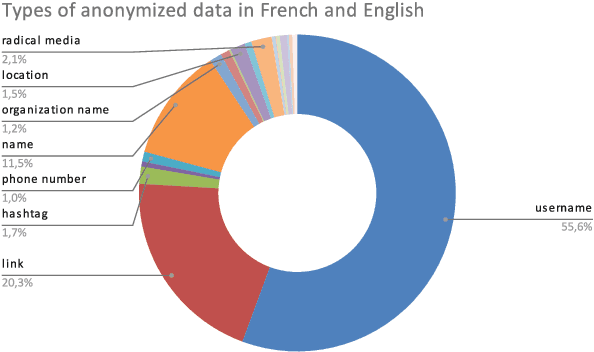
Abstract:Protecting privacy is essential when sharing data, particularly in the case of an online radicalization dataset that may contain personal information. In this paper, we explore the balance between preserving data usefulness and ensuring robust privacy safeguards, since regulations like the European GDPR shape how personal information must be handled. We share our method for manually pseudonymizing a multilingual radicalization dataset, ensuring performance comparable to the original data. Furthermore, we highlight the importance of establishing comprehensive guidelines for processing sensitive NLP data by sharing our complete pseudonymization process, our guidelines, the challenges we encountered as well as the resulting dataset.
From Text to Source: Results in Detecting Large Language Model-Generated Content
Sep 23, 2023Abstract:The widespread use of Large Language Models (LLMs), celebrated for their ability to generate human-like text, has raised concerns about misinformation and ethical implications. Addressing these concerns necessitates the development of robust methods to detect and attribute text generated by LLMs. This paper investigates "Cross-Model Detection," evaluating whether a classifier trained to distinguish between source LLM-generated and human-written text can also detect text from a target LLM without further training. The study comprehensively explores various LLM sizes and families, and assesses the impact of conversational fine-tuning techniques on classifier generalization. The research also delves into Model Attribution, encompassing source model identification, model family classification, and model size classification. Our results reveal several key findings: a clear inverse relationship between classifier effectiveness and model size, with larger LLMs being more challenging to detect, especially when the classifier is trained on data from smaller models. Training on data from similarly sized LLMs can improve detection performance from larger models but may lead to decreased performance when dealing with smaller models. Additionally, model attribution experiments show promising results in identifying source models and model families, highlighting detectable signatures in LLM-generated text. Overall, our study contributes valuable insights into the interplay of model size, family, and training data in LLM detection and attribution.
Towards a Robust Detection of Language Model Generated Text: Is ChatGPT that Easy to Detect?
Jun 09, 2023


Abstract:Recent advances in natural language processing (NLP) have led to the development of large language models (LLMs) such as ChatGPT. This paper proposes a methodology for developing and evaluating ChatGPT detectors for French text, with a focus on investigating their robustness on out-of-domain data and against common attack schemes. The proposed method involves translating an English dataset into French and training a classifier on the translated data. Results show that the detectors can effectively detect ChatGPT-generated text, with a degree of robustness against basic attack techniques in in-domain settings. However, vulnerabilities are evident in out-of-domain contexts, highlighting the challenge of detecting adversarial text. The study emphasizes caution when applying in-domain testing results to a wider variety of content. We provide our translated datasets and models as open-source resources. https://gitlab.inria.fr/wantoun/robust-chatgpt-detection
Data-Efficient French Language Modeling with CamemBERTa
Jun 02, 2023Abstract:Recent advances in NLP have significantly improved the performance of language models on a variety of tasks. While these advances are largely driven by the availability of large amounts of data and computational power, they also benefit from the development of better training methods and architectures. In this paper, we introduce CamemBERTa, a French DeBERTa model that builds upon the DeBERTaV3 architecture and training objective. We evaluate our model's performance on a variety of French downstream tasks and datasets, including question answering, part-of-speech tagging, dependency parsing, named entity recognition, and the FLUE benchmark, and compare against CamemBERT, the state-of-the-art monolingual model for French. Our results show that, given the same amount of training tokens, our model outperforms BERT-based models trained with MLM on most tasks. Furthermore, our new model reaches similar or superior performance on downstream tasks compared to CamemBERT, despite being trained on only 30% of its total number of input tokens. In addition to our experimental results, we also publicly release the weights and code implementation of CamemBERTa, making it the first publicly available DeBERTaV3 model outside of the original paper and the first openly available implementation of a DeBERTaV3 training objective. https://gitlab.inria.fr/almanach/CamemBERTa
Multilingual Auxiliary Tasks Training: Bridging the Gap between Languages for Zero-Shot Transfer of Hate Speech Detection Models
Oct 25, 2022Abstract:Zero-shot cross-lingual transfer learning has been shown to be highly challenging for tasks involving a lot of linguistic specificities or when a cultural gap is present between languages, such as in hate speech detection. In this paper, we highlight this limitation for hate speech detection in several domains and languages using strict experimental settings. Then, we propose to train on multilingual auxiliary tasks -- sentiment analysis, named entity recognition, and tasks relying on syntactic information -- to improve zero-shot transfer of hate speech detection models across languages. We show how hate speech detection models benefit from a cross-lingual knowledge proxy brought by auxiliary tasks fine-tuning and highlight these tasks' positive impact on bridging the hate speech linguistic and cultural gap between languages.
Towards Unsupervised Content Disentanglement in Sentence Representations via Syntactic Roles
Jun 22, 2022
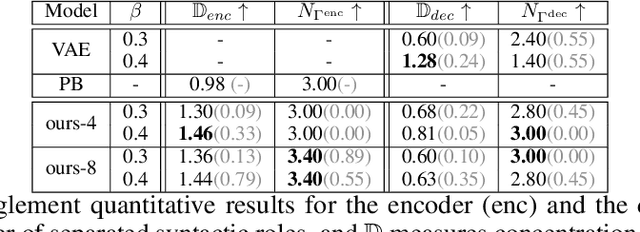
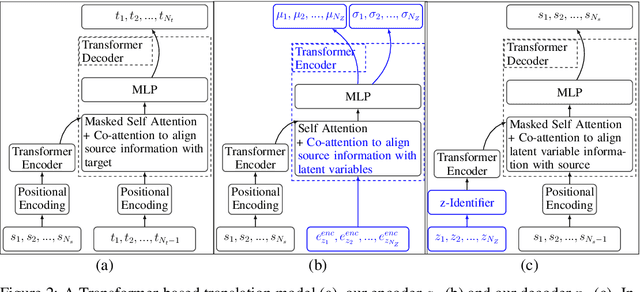

Abstract:Linking neural representations to linguistic factors is crucial in order to build and analyze NLP models interpretable by humans. Among these factors, syntactic roles (e.g. subjects, direct objects,$\dots$) and their realizations are essential markers since they can be understood as a decomposition of predicative structures and thus the meaning of sentences. Starting from a deep probabilistic generative model with attention, we measure the interaction between latent variables and realizations of syntactic roles and show that it is possible to obtain, without supervision, representations of sentences where different syntactic roles correspond to clearly identified different latent variables. The probabilistic model we propose is an Attention-Driven Variational Autoencoder (ADVAE). Drawing inspiration from Transformer-based machine translation models, ADVAEs enable the analysis of the interactions between latent variables and input tokens through attention. We also develop an evaluation protocol to measure disentanglement with regard to the realizations of syntactic roles. This protocol is based on attention maxima for the encoder and on latent variable perturbations for the decoder. Our experiments on raw English text from the SNLI dataset show that $\textit{i)}$ disentanglement of syntactic roles can be induced without supervision, $\textit{ii)}$ ADVAE separates syntactic roles better than classical sequence VAEs and Transformer VAEs, $\textit{iii)}$ realizations of syntactic roles can be separately modified in sentences by mere intervention on the associated latent variables. Our work constitutes a first step towards unsupervised controllable content generation. The code for our work is publicly available.
 Add to Chrome
Add to Chrome Add to Firefox
Add to Firefox Add to Edge
Add to Edge